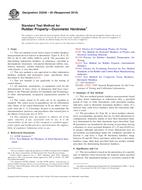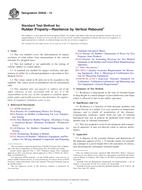Potřebujeme váš souhlas k využití jednotlivých dat, aby se vám mimo jiné mohly ukazovat informace týkající se vašich zájmů. Souhlas udělíte kliknutím na tlačítko „OK“.
ASTM D4482-11
Test Method for Rubber PropertyExtension Cycling Fatigue
Automaticky přeložený název:
Zkušební metoda pro Rubber PropertyExtension Cyklistika Únava
NORMA vydána dne 1.5.2011
Informace o normě:
Označení normy: ASTM D4482-11
Poznámka: NEPLATNÁ
Datum vydání normy: 1.5.2011
Kód zboží: NS-27399
Počet stran: 10
Přibližná hmotnost: 30 g (0.07 liber)
Země: Americká technická norma
Kategorie: Technické normy ASTM
Kategorie - podobné normy:
Anotace textu normy ASTM D4482-11 :
Keywords:
fatigue, fatigue life, strain energy: Cycle method, Cracking--rubber, Fatigue, Natural rubber (NR), Rubber property analysis, Strain testing, Tensile properties/testing--rubber/related materials, ICS Number Code 83.060 (Rubber)
Doplňující informace
| Significance and Use | ||||||||
|
This test method covers one procedure for determining fatigue life at various extension-ratios. The strain cycle is characteristic of the type of test apparatus specified. Experience in fatigue testing shows that fatigue life may have a wide, non-normal distribution and, therefore, a large standard deviation that is compound dependent. Natural rubber, for example, has shown a narrower distribution than many synthetic rubbers. A large number of specimens may, therefore, be required to yield the desired precision. Comparison of different rubber compounds should be made with due consideration to the standard deviation for each (see 7.1). Fatigue data, as generated in this test method, give primarily an estimate of the crack initation behavior of a rubber vulcanizate and only a very approximate measure of the crack propagation rate. The information obtained may be useful in predicting the flex-life performance of a compound in active service; however, the user should be aware that in actual use, products are subjected to many other fatigue factors not measured in this test method. |
||||||||
| 1. Scope | ||||||||
|
1.1 This test method covers the determination of fatigue life of rubber compounds undergoing a tensile-strain cycle. During part of the cycle, the strain is relaxed to a zero value. The specimens are tested without intentionally initiated flaws, cuts, or cracks. Failure is indicated by a complete rupture of the test specimen. 1.2 No exact correlation between these test results and service is given or implied. This is due to the varied nature of service conditions. These test procedures do yield data that can be used for the comparative evaluation of rubber compounds for their ability to resist (dynamic) extension cycling fatigue. 1.3 The values stated in SI units are to be regarded as standard. The values given in parentheses are for information only. 1.4 This standard does not purport to address all of the safety concerns, if any, associated with its use. It is the responsibility of the user of this standard to establish appropriate safety and health practices and determine the applicability of regulatory limitations prior to use. |
||||||||
| 2. Referenced Documents | ||||||||
|
Podobné normy:
Historická
1.1.2010
Historická
1.7.2014
Historická
1.5.2013
Historická
1.11.2013
Historická
1.5.2012
Historická
1.7.2010
Doporučujeme:
Aktualizace zákonů
Chcete mít jistotu o platnosti užívaných předpisů?
Nabízíme Vám řešení, abyste mohli používat stále platné (aktuální) legislativní předpisy.
Chcete vědět více informací? Podívejte se na tuto stránku.



 ASTM D2240-05(2010)..
ASTM D2240-05(2010).. ASTM D2632-14
ASTM D2632-14 ASTM D297-13
ASTM D297-13 ASTM D3137-81(2013)..
ASTM D3137-81(2013).. ASTM D3182-07(2012)..
ASTM D3182-07(2012).. ASTM D3183-10
ASTM D3183-10
 Cookies
Cookies
